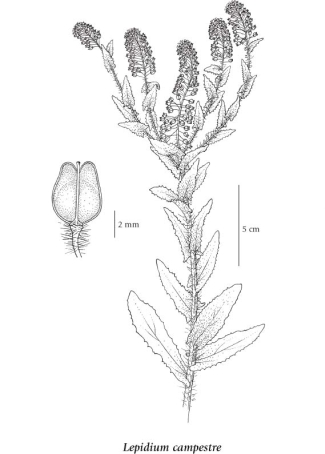Lepidium campestre (L.) W.T. Aiton
field pepper-grass (field pepperweed)
Brassicaceae (Mustard family)
Introduction to Vascular Plants
field pepper-grass (field pepperweed)
Brassicaceae (Mustard family)
Introduction to Vascular Plants
Species Information
General:
Annual or biennial herb from a taproot; stems mostly single, erect, branched above, leafy to the inflorescenses, 20-50 cm tall, spreading short-hairy.
Leaves:
Basal leaves in a rosette, oblanceolate, stalked, entire to pinnately cut with a large terminal lobe, 5-7 cm long, to 12 mm wide; stem leaves numerous, arrowhead-shaped, minutely toothed, unstalked, upper strongly ear-like and clasping at the base.
Flowers:
Inflorescence of often compound racemes; flower stalks widely spreading, 4-8 mm long, slightly flattened; petals white, about 2 mm long, narrowly spoon-shaped; sepals often pinkish, about 1.5 mm long, nearly glabrous to long-hairy; stamens 6; anthers yellow.
Fruits:
Silicles, oblong egg-shaped, 5-6 mm long, 4 mm wide, covered with white blisters, otherwise glabrous to short-hairy, margins and tips broadly winged, the tips slightly notched; beaks 0.2-0.6 mm long, included to slightly exserted at the shallowly notched tips; seeds 2.5-3 mm long.
Illustration

If more than one illustration is available for a species (e.g., separate illustrations were provided for two subspecies) then links to the separate images will be provided below. Note that individual subspecies or varietal illustrations are not always available.
Illustration Source: The Illustrated Flora of British Columbia
Ecology
Ecological Framework for Lepidium campestre
The table below shows the species-specific information calculated from
original data (BEC database) provided by the BC Ministry of Forests and Range.
(Updated August, 2013)
The table below shows the species-specific information calculated from
original data (BEC database) provided by the BC Ministry of Forests and Range.
(Updated August, 2013)
| Site Information |
Value / Class |
||
|
Avg |
Min |
Max |
|
| Elevation
(metres) |
805 | 735 | 875 |
| Slope
Gradient (%) |
18 | 0 | 37 |
|
Aspect (degrees) |
125 | 125 | 125 |
| Soil
Moisture Regime (SMR) [0 - very xeric; 4 - mesic; 8 - hydric] |
3 | 3 | 4 |
| Modal
Nutrient Regime
Class |
C | ||
| #
of field plots species was recorded in: |
2 | ||
| Modal
BEC Zone Class |
PP | ||
|
All BEC Zones (# of stations/zone) species was recorded in |
PP(2) | ||
|
Source:
Klinkenberg 2013
|
|||
Habitat and Range
Dry fields, roadsides and waste places in the steppe and montane zones; infrequent in S BC; introduced from Eurasia.Status Information
Synonyms
Synonyms and Alternate Names:
Neolepia campestris (L.) W.A. Weber
Thlaspi campestre L.